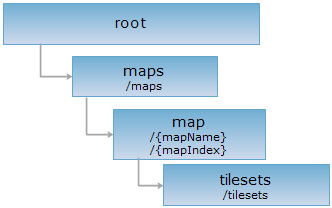
<map uri>/tilesets[.<format>]
The tilesets resource. For different tilesets, they have different tile versions, tile sizes, transparencies. Users can get the tileset information by implementing the GET request.
Supported Methods:
Supported output formats: rjson, json, html, xml.

Suppose we implement HTTP request on the following URI and take rjson as the output format. where supermapiserver is the server name, "China1:400Million" is the map name ({mapName}) and URI is the tileset tileset list of "China1:400Million".
http://supermapiserver:8090/iserver/services/map-world/rest/maps/China1:400Million/tilesets.rjson
Gets the tileset list.
A tileset list will be returned by implementing the GET request on the tilesets resource. The representation structure of a single tileset will be as follows:
| Field | Type | Description |
| name | String | The tileset name. |
| metaData | MetaData | The map tile metadata information. |
| tileVersions | TileVersion[] | The tile version array. A tileset can contain multiple tile versions. |
The representation in rjson format returned by implementing the GET request http://supermapiserver:8090/iserver/services/map-world/rest/maps/China1:400Million/tilesets.rjson will be as follows:
Asks for the response identical to the one that would correspond to a GET request, but without the response body. This is useful for retrieving meta-information written in response headers, without having to transport the entire content. The meta-information includes the media-type, content-encoding, transfer-encoding, content-length, etc.
HEAD request can be used to check if the tilesets resource exists, or if the tilesets resource can be accessed by clients. It can also determine if the tilesets resource supports an output format <format> if performed on a URI with .<format> included.